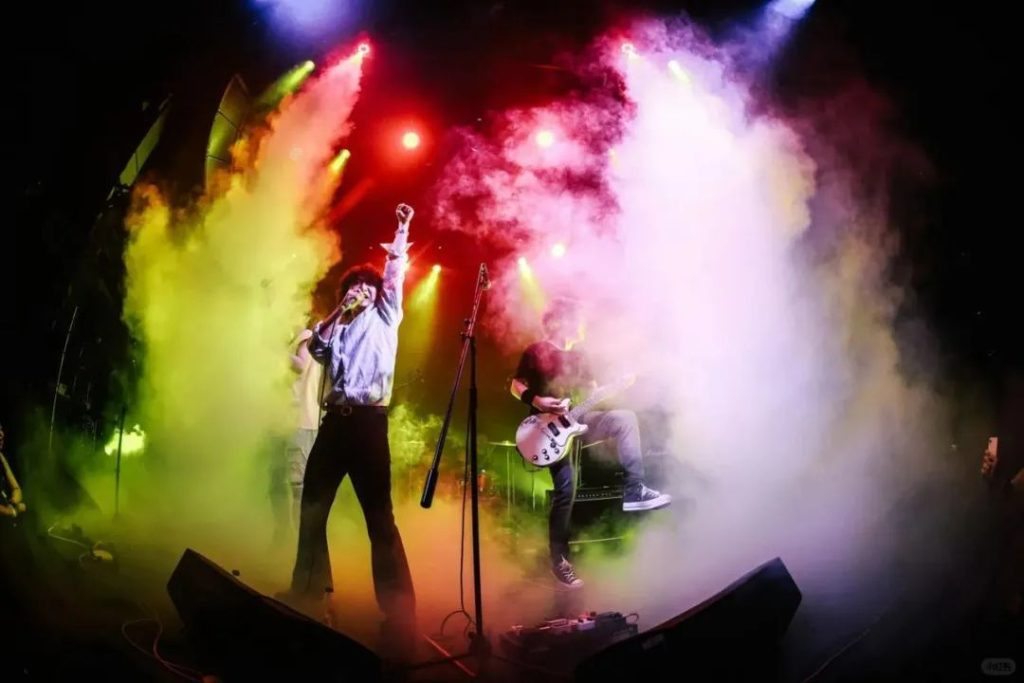
Positive Comments:拼盘演出仍是独立音乐生态的“毛细血管”,为新乐队与乐迷搭建关键桥梁
In the current independent music market, although joint performances face numerous challenges, their value as the “infrastructure” of the industry is irreplaceable. From the lively scene of DDC’s 11th anniversary party in the news, it can be seen that when multiple bands with different styles perform on the same stage, it can not only meet the fans’ demand for diverse music but also provide low – cost exposure opportunities for new bands. For independent musicians who haven’t accumulated enough fans, joint performances are the inevitable path from the “underground” to the “surface” – they don’t need to bear the high venue fees and publicity costs of solo concerts. With just a 30 – minute performance, they can reach potential fans and accumulate seed users for subsequent tours. The Soft Persimmon Band mentioned in the news gradually built up its box – office appeal through the “capillary – style tour” (43 stops within a year), and the starting point of these tours is often the joint performance stage.
From the perspective of fans’ experience, small – venue joint performances naturally have the advantage of “close – range interaction”. Liu Fei, the manager of SCHOOL, mentioned that “small venues are more suitable for joint performances”. Essentially, in a space with less than 200 people, the distance between musicians and the audience is shortened, and the “sacredness” of the stage is transformed into a sense of “participation”. The scene described in the news at the DDC, where the audience swayed to the rhythm and was ignited by the energy of the bands, is a typical manifestation of this “immersive experience”. This kind of experience can not only cultivate fans’ long – term interest in independent music but also generate secondary exposure through social media dissemination (such as fans sharing performance clips), bringing more potential users to the bands and the venue.
What’s more commendable is that some high – quality joint performances have explored a positive cycle driven by “content”. The phenomenon mentioned in the news that fans traveled between multiple venues to watch their favorite bands at the TOCONOMA performance at Jiangjinjiu confirms the law that “good content always has a market”. When the event organizer can accurately select a combination of bands with complementary styles and unique features, the joint performance can completely produce a “1 + 1>2” effect – the audience comes for one band but is attracted by other bands, ultimately extending the viewing time, increasing consumption (such as buying merchandise and drinks), and even becoming long – term members of the venue. In this model, joint performances are not just a “ticket – selling tool” but also an “incubator” for music culture dissemination.
Negative Comments: Fragile profit model, lack of contract spirit, and loss of audience, joint performances are in “survival anxiety”
Despite their irreplaceability, the survival environment of current joint performances has become increasingly severe. The core contradiction lies in the imbalance between “high costs” and “limited income”. The detailed cost calculation in the news reveals the seriousness of the problem: for a joint performance with 4 bands, just the band performance fees (4×5000 yuan), venue ticket – sharing costs (6000 yuan), and technical staff fees (2000 yuan) already amount to 28,000 yuan. Calculated at 100 yuan per ticket, 280 tickets need to be sold to break even. If we add publicity and promotion, ticket – sharing (usually 10% – 15% of the box office), and labor costs, the actual break – even point may exceed 350 tickets. In reality, the box office of most independent band joint performances is often between 100 – 200 tickets, and losses have almost become the norm. The case of Kuanzi’s label not holding a performance for half a year and losing 3000 yuan in the last one is a microcosm of how small and medium – sized event organizers are “cautiously struggling for survival”.
What’s more troublesome is the lack of contract spirit in the industry, which directly shakes the trust foundation of the performance ecosystem. The “verbal agreement breach” incident that the Soft Persimmon Band encountered is a typical example: the event organizer not only delayed signing the contract and suddenly cancelled the cooperation but also publicly belittled the band in the fans’ group. This kind of behavior not only damaged the band’s economic interests (the 5000 – yuan performance fee was not settled) but also destroyed the trust chain among the “event organizer – band – fans”. The news mentioned that “there are too many performances cancelled without reason”. In essence, some event organizers regard joint performances as a “low – risk trial – and – error” tool – they default on the contract when they anticipate a loss, ignoring the time (rehearsal, travel) and opportunity costs (giving up other performance invitations) that the bands have invested in the performance. In the era of transparent information on social media, although such behaviors will be “exposed on Xiaohongshu as a warning”, the damage to the overall credibility of the industry is difficult to reverse.
The phenomenon of fans’ “migratory bird – style attendance” further exacerbates the embarrassment of joint performances. Fans rush to the venue just for a specific band, resulting in an alternation of “half – empty” and “full” audiences in front of the stage. There has even been an extreme situation where “the audience left after the guest band finished performing, and the headlining band only faced two audiences”. In this model, the event organizer’s box – office revenue is seriously diluted – the audience may buy only one ticket but only watch one band, and the performances of the remaining bands fail to be converted into actual revenue; at the same time, the bands’ performance experience is damaged (performing in front of an empty venue is demotivating), and in the long run, it may weaken their willingness to participate in joint performances. The trend of mid – tier bands “aiming for a thousand – seat venue” has also put joint performances into a vicious cycle where “top – tier bands disdain to participate, and new bands lack appeal”, further compressing the supply of high – quality content.
Advice for entrepreneurs: From “survival anxiety” to “ecosystem co – construction”, a precise solution is needed
For event organizers, the key is to establish a dual – wheel model of “refined cost control + content differentiation”. First, on the cost side, they need to abandon the thinking of “putting bands together just for the sake of quantity” and select band combinations according to the preferences of the target fans. For example, if the target group is independent rock enthusiasts, they can choose 3 bands with similar but distinct styles (instead of 4 – 5 bands) to reduce redundant costs; at the same time, negotiate a more flexible revenue – sharing model with the venue (such as “low minimum guarantee + high sharing ratio”) to reduce the risk of fixed expenses. Second, on the content side, they need to strengthen the “thematic nature”. For example, plan joint performances with themes such as “urban culture” (e.g., Beijing alley music) or “style fusion” (post – rock + electronic) to attract niche fan groups, increase the audience’s staying time, and promote secondary consumption (such as drinks and merchandise).
For independent bands, they need to be clear that “joint performances are a springboard rather than an end – point” and actively improve their “ticket – bringing ability” to争取 more favorable cooperation conditions. On the one hand, bands should continuously share performance clips and creative stories on social media (such as Bilibili and Xiaohongshu) to accumulate “online fans” and convert them into offline box – office sales; on the other hand, they can negotiate a “ticket – sharing cooperation” with the event organizer (that is, the band is responsible for selling some tickets and gets a share according to the proportion), reducing the event organizer’s cost pressure and at the same time proving their commercial value. For example, the box – office appeal that the Soft Persimmon Band built through 43 stops of tours in the news is an important bargaining chip for its negotiation with the event organizer.
For the industry ecosystem, there is an urgent need to establish a restraint mechanism for “contract spirit” and a cooperation model of “risk – sharing”. On the one hand, event organizers and bands should sign clear written contracts, stipulating compensation clauses for performance cancellation (such as paying 50% of the performance fee if cancelled 15 days in advance), and using legal means to reduce default behaviors; on the other hand, they can explore the “label alliance” model, where multiple small labels jointly invest and share risks, and jointly plan high – quality joint performances. This can not only reduce the financial pressure on individual labels but also improve the publicity efficiency through resource integration (such as sharing fan communities and joint promotion).
Finally, all participants need to return to the essence of “content is king”. Whether it is the event organizer screening bands, the bands polishing their works, or the venue optimizing services (such as improving the sound effect and increasing merchandise sales), the core goal is to create an experience for fans that is “worth a special trip”. When joint performances change from “just selling tickets” to a “window for discovering good music”, their survival dilemma will naturally be solved – after all, fans are always willing to pay for high – quality content, which is the most fundamental growth logic of the industry.
- Startup Commentary”Building LLMs: The Knowledge Graph Foundation Every AI Project Needs”
- Startup Commentary”The 17th Year of Tmall Double 11 and the New Map Rewritten by AI”
- Startup Commentary”How to Prepare Your Data for Artificial Intelligence”
- Startup Commentary”Small and Medium-sized Banks: “Cutting the Tail” in Loan Assistance”
- Startup Commentary”The Six AI Giants on Stage: AGI Is No Longer a “Future” Thing”




